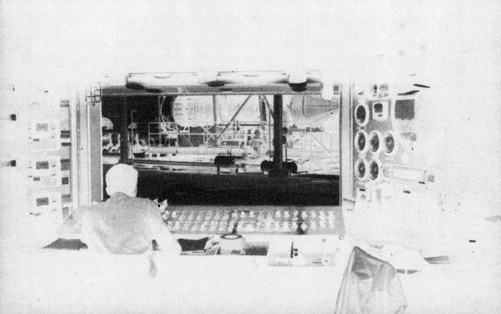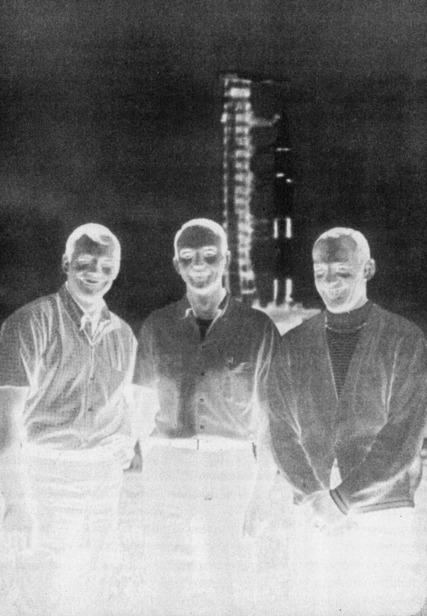The History of Florida (108 page)
Read The History of Florida Online
Authors: Michael Gannon
Tags: #History, #United States, #State & Local, #Americas

football teams achieved astounding levels of success), by professional foot-
ball teams in Miami, Tampa, and Jacksonville, by the Miami Marlins and
Tampa Bay Rays Major League Baseball teams, and by professional basket-
ball and soccer franchises. The improbable presence of two professional ice
hockey teams in Florida is a testament to Sunbelt technology, economics,
and demographics.
Sports, retirement, and tourism have helped shape Florida’s image and
propelled its economy. But in the years after World War II, powerful new
forces of change emerged. The war itself had a tremendous impact. Military
training facilities, air bases, naval bases, and major shipyards sprouted all

516 · Raymond A. Mohl and Gary R. Mormino
over the state. Service personnel and their families migrated to Florida, and
many thousands returned to live when the war was over. Miami, Tampa,
Jacksonville, and Pensacola especial y benefitted from military investment
and enormous military payrol s. Huge federal wartime expenditures in
Florida and throughout the Sunbelt produced essential new infrastructure,
supported local economies, and stimulated construction and service in-
dustries. By the 1980s, defense spending and military payrolls in Florida
surpassed $15 bil ion annual y. Underlying much of the nation’s changing
economic and urban pattern in the postwar era has been the redirection of
federal resources through military and defense spending, and this “military
remapping” of America had special salience for Florida in the second half
of the twentieth century. With the end of the Cold War, however, the federal
military-industrial complex, once so vital to Florida’s defense industries and
military bases, began to shrink. In 2011, NASA ended the three-decade-long
U.S. space shuttle program, causing massive layoffs. The Kennedy Space
Center’s workforce has been drastical y reduced to 8,500 workers, the smal -
est number in more than three decades.
proof
[Fig 25.4] In 1959, a Pratt and Whitney engineer monitors a jet engine test in Palm
Beach County. The 1950s marked the beginning of a dramatic increase in the number
of industries that took root in Florida. In addition to Pratt and Whitney, these included
Martin Aircraft, Sperry Rand, IBM, Maxwell House, Anheuser-Busch, and Disney World.
The last-named corporation opened the Magic Kingdom in 1971 and Epcot Center in
1982, which together would draw more visitors each year than Florida had residents.

Boom, Bust, and Uncertainty: A Social History of Modern Florida · 517
proof
No event in its history brought Florida more national and international notice than did
the launch of Apollo XI from Cape Kennedy on 16 July 1969. The rocket and space ve-
hicle enabled American astronauts Neil A. Armstrong (
left
) and Edwin E. Aldrin (
right
)
to become the first humans to walk on the surface of the moon. At the center of this
photograph, taken beforehand, with the launch pad in the background, is Michael
Collins, pilot of the mission command module.
The postwar federal presence was important, but a series of powerful eco-
nomic changes also shaped post-1950 Florida. Scholars have begun to sketch
the full dimensions of a long-term structural transformation of the Ameri-
can economy that dates back to the 1950s—a process of “deindustrialization”
that has resulted in the dismantling and abandoning of much of the nation’s
increasingly obsolete industrial infrastructure. Taking the place of the aging
Rustbelt factory industries are the dynamic new industries of the postin-
dustrial economy—the high-tech, computerized information businesses
518 · Raymond A. Mohl and Gary R. Mormino
and the more ful y developed (and low-paying) service economy. The new
American economy grew up around services provided by government, edu-
cational agencies, and financial services companies; it was spurred also by
health care and medical delivery, food service, travel and entertainment,
and retailing and consumerism. Fast food, motel chains, and car rentals,
sprawling mal s and shopping centers, lawn service and office temps, rent-a-
maid and rent-a-nurse—these are some of the businesses that have emerged
at the low end of Florida’s recent economy, paralleling but hardly supplant-
ing an older low-paid service economy centered on restaurant staff, hotel
maids, and migrant farmworkers.
A high end of the new service economy has emerged, as wel . In the new
information age, the high-tech and business service economy is no lon-
ger tied to older metropolitan centers of the Northeast or Midwest. With
computer networks and other instantaneous communication, it has been
possible for major corporations—and individuals with a laptop—to relo-
cate to Tampa, Miami, Boca Raton, or Sanibel Island; costs are reduced for
company and employees alike, and al benefit from the low taxes, sunny
climate, and enhanced amenities. Florida’s new economy includes high-
tech and computer companies in the state’s “Silicon Beach” area stretching
along the Atlantic coast north from Miami and in the Cape Canaveral area.
proof
The wondrous technological innovation of the late twentieth century, the
personal computer, was developed at IBM’s massive facility in Boca Raton.
Major international trade and banking operations have clustered in Miami
and Coral Gables since the early 1970s. Miami is scarcely the Hong Kong of
the West, but many business and civic leaders have aspired to enhance south
Florida’s place in the emerging global economy. In the late 1990s and into
the new century, Florida governors invested heavily to bring biotech firms
to the Jupiter Island area. Some critics question the investment and return.
Florida must continue to adjust and cope with the new technologies and
global economic networks that will shape the twenty-first century.
New technologies and economies have helped to create modern Florida,
but issues involving race and immigration have generated a more powerful
impact in shaping national and world images of the state. Florida, in fact,
has had a long and troubled history in the area of race relations. In the past,
the legitimacy of its role as a “real” southern state was the subject of frequent
debate, but the history of race relations in Florida leaves little doubt as to the
answer. Florida’s color line, drawn in exacting constitutional detail and ce-
mented in everyday custom, swept across geographical and time boundar-
ies. Jim Crow practices found easy acceptance even in Florida cities without
Boom, Bust, and Uncertainty: A Social History of Modern Florida · 519
southern-born populations, such as St. Petersburg, Miami, and Palm Beach.
In tourist cities, leaders stressed the importance of maintaining a strict color
line and docile black communities, making sure that blacks would serve but
not be seen. When in Florida, most northerners adapted easily to southern
racial customs and segregation. In Miami, Gainesville, Sarasota, and other
places, some northerners, outraged at the status quo, courageously joined
and led the civil rights movement.
Lynching, of course, loomed as the ultimate test of keeping blacks in
their place. Historical y, white Floridians vigilantly used the noose and the
torch to control economic power and enforce southern customs. Florida,
not Alabama or Mississippi, led the South in lynchings in proportion to
population. Vigilante justice was not confined to Jefferson, Levy, Marion,
or Jackson Counties in rural north Florida; Hernando, Pasco, Citrus, Polk,
Hil sborough, and DeSoto Counties recorded especial y notorious acts of
racial violence. Nor was the violence limited to isolated cases and individ-
ual victims. Attacks on entire black communities took place at Lake City,
Ocoee, and Rosewood between 1912 and 1923. African Americans were not
passive victims; rather, they fought back as at Rosewood, and organized
boycotts of streetcars, as in Jacksonvil e and Pensacola between 1901 and
1905. In some cities, such as Miami and West Palm Beach, they joined Mar-
proof
cus Garvey’s black nationalist Universal Negro Improvement Association
in large numbers. Until the 1940s, pol taxes and white primaries largely
kept them from the voting booth most of the time, but when possible (as
in nonpartisan municipal elections in Miami), blacks turned out in force to
exercise the franchise.
Enforcement of the Florida color line continued forceful y after World
War II. In Miami, over a six-year period beginning in 1946, an active Ku
Klux Klan regularly paraded, burned crosses, torched houses, and dyna-
mited apartment complexes in an effort to keep blacks from moving into
white neighborhoods. In 1951, in the small Brevard County town of Mims,
the Klan dynamited the home of Harry T. Moore, a relentless civil rights
activist and statewide leader of the NAACP, killing him and his wife. Na-
tional magazines published articles in the 1950s with such titles as “The
Truth about the Florida Race Troubles,” “Florida: Dynamite Law Replaces
Lynch Law,” “Bigotry and Bombs in Florida,” and “Bombing in Miami.”9
Big-city police departments in Miami, Tampa, and Jacksonville vigorously
enforced the color line, often violently.
African American activism shaped the civil rights movement in Florida,
even in the 1940s and 1950s before the national freedom struggle took off. A
520 · Raymond A. Mohl and Gary R. Mormino
bus boycott in Tal ahassee in 1956 inspired a wider civil rights movement in
the state capital. Lunch-counter sit-ins led by the Miami branch of CORE in
1959 (a year before the more celebrated sit-ins in Greensboro, North Caro-
lina) ultimately led to the desegregation of Miami’s public accommodations
and schools. But the civil rights movement was accompanied by racial con-
flict in the 1960s and after. Violent police behavior in the ghetto prompted
Miami’s Liberty City riot of 1980, and troubled police-community relations
persisted in Miami and Tampa through the 1980s. Even as Florida became
less southern, traditional patterns of race relations persisted. Urban upris-
ings in late-twentieth-century Miami and St. Petersburg and extensive me-
dia coverage of Florida’s racial conflicts initiated new popular images of the
state. Few were happy with either the broad outlines or the minute details
of that image.
Immigration patterns since the mid-1960s have also dramatical y recast
Florida’s image. The Cuban refugee exodus that began in 1959, episodic but
relentless over time, has brought such tumult and change in south Florida
that words such as “transformative” and “profound” seem inadequate. By
the 1990s, close to 1 million Cuban exiles had made the journey across the
Florida Straits. They and others have transformed Miami into the capital
of the Caribbean and Latin America. The Cubans were fol owed by mas-
proof
sive migrations of Haitians and Nicaraguans and smaller contingents from
virtual y every Caribbean and Latin American nation. These migrations
remade Miami and eventual y al of south Florida. The demographic and
cultural changes have been phenomenal—in 2010, some 1.4 mil ion resi-
dents of Miami-Dade County spoke Spanish, a figure outnumbering Eng-